Controls
Controls provide lighting flexibility and reduce energy costs.
Switches
- Children or people in wheel chairs can more easily reach switches installed less than 4 feet from the floor. Switches installed under 4 feet are also under the drywall seam.
- Room entrances make convenient locations for switches. Manufacturers make three-way or four-way switches for rooms that have more than one or two entrances.
- In lighted closets with swinging doors, a door switch (a small switch mounted on the inside face of the door jamb) can automatically turn off the closet light when the door is closed.
- If a luminaire cannot be seen from a switch location, such as an exterior light or basement light controlled from the top of an enclosed stair, a switch with a small indicator light warns that the light has been left on.
Dimmers
- A dimmer installed in the wall switch box provides a range of light outputs in a space. Lower-wattage or fewer lamps are better solutions for providing consistently less light.
 Any circuit that has a low-voltage lamp requires a dimmer designed for low-voltage lamps.
Any circuit that has a low-voltage lamp requires a dimmer designed for low-voltage lamps.
- A dimming ballast must be installed to dim fluorescent lamps. A fluorescent lamp dimmer works in tandem with the dimming ballast to lower the light level. The wiring diagrams provided by manufacturers are important because fluorescent lamp dimmers require more wiring than incandescent lamp dimmers.
- Do not install any fluorescent lamps, including a screwbase compact fluorescent lamp, in a luminaire controlled by an incandescent lamp dimmer.
- Receptacles should not be dimmer controlled; a non-dimmable appliance plugged into a dimmed receptacle may be damaged from operation on the reduced power of a dimmed circuit.
- Verify with instructions the maximum load of a dimmer and its required derating for installation in multi-gang boxes. Use commercial-grade dimmers if the connected load exceeds 600 watts.
Timers
- Rooms that are infrequently occupied and luminaires that are operated for short periods of time, including vanity lights, bathroom heat lamps, closet lights, and pantry lights, provide the best applications for interval timers.
- Solid-state electronic interval timers operate quietly.
- Timers are not appropriate for showers and rooms where people could be stranded in the dark if the lamps turn off.
Motion Detectors
- Motion detectors automatically switch off lights. Motion detectors are useful in rooms where lamps are often left on, such as bedrooms, bathrooms, walk-in closets, and exterior applications.
- In homes, install motion detectors in place of standard wall switches. Some motion detectors fit standard
"Decora"-style wallplates.

- For interiors, manual on/automatic off motion detectors do not turn on the lamps unless someone touches the switch, so pets and incidental movement don't trigger the detectors. These detectors turn off the lights when no motion is sensed for a set period of time.
CAUTION - High-intensity discharge (HID) lamps including metal halide, high- pressure sodium, and mercury vapor lamps take several minutes to come up to full brightness when they are switched on and, therefore, shouldn't be used with motion detectors because instant full light output may be important.
| Next Section |


